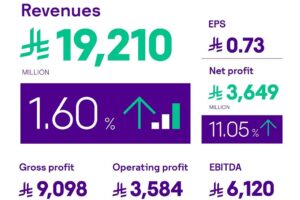Manish Mangal, Global Head of 5G & Network Services Business, Tech Mahindra
Communication Service Provider (CSP) transformation programs for 5G will have to be designed for a world with continuous change. This means that transformation programs will have to change from a big bang, multi-year plan to one that lets CSPs keep improving their operating and business models in response to the constant change in both their enterprise and retail business units.
The enhanced offerings that the enhanced CSP business model demands for both private and public 5G will require CSPs to transform not just their architectures, or systems for networks, data centres, and back, central, and front offices, but also their cultures and partnership models to enable new monetization and operational models. Without CSPs switching to a platform business model, these changes can’t happen.
Platform-based business models are more effective at bundling new digital products and services with legacy telco services into broader digital solutions that are more effective in meeting the diverse requirements and needs of customers than existing alternatives. Platforms also enable a consistent customer experience across multiple product lines or customer journeys, a requisite for the way these new digital solutions will be discovered, evaluated, accessed, and consumed. By giving access to richer digital data at each step of the value chain, platforms provide deeper insights into business processes and customers. This makes it possible to make more personalized products and use context-based marketing, as well as close the loop on the next wave of innovation.
Adopting a platform business model requires CSPs to reconsider their approach to digital transformation. CSPs’ multi-year, multi-million-dollar digital transformation efforts have focused on establishing digital capabilities within their legacy stacks to improve operational efficiency through business process simplification and automation. While operational efficiency-derived cost reduction remains an essential consequence for CSPs, the scope of transformation shifts in a platform business model, with revenue growth from new business models and ecosystems taking precedence.
Devising the RIGHT Strategy
Gartner predicts that “by 2023, 35% of roles within CSP organizations will be either new or redesigned.” CSPs will have to first take care of the cultural factors if they are to have any chance of success with the technology and strategic imperatives required to achieve digital dexterity. CSPs will also have to be conscious of external factors. Changes in geopolitics, regulations, and the economy, as well as global pandemics and the rise of new digital competitors, can have a big effect on transformation programs or even make them obsolete.
CSP transformation programs will now have to be designed for a world where continuous change is the norm. A successful CSP 5G implementation shouldn’t look at 5G as a technology that just improves the old connectivity technologies. Instead, it should look at 5G as a platform that enables business outcomes for different industries, where better connectivity is only one part of the solution. This will necessitate transformation programs changing from a big bang, multi-year program to one that allows CSPs to continuously innovate their operating and business models in response to continuous change across both the enterprise and retail business units of the CSP. The core of CSP’s 5G transformation strategy will be to use new technologies or methods like open-source software, artificial intelligence, Agile and DevOps, cloud computing, and virtualization. They will also need to rethink their culture and organization structures, especially when it comes to reskilling the workforce.
For internet-based companies, the move toward platform business models has been a major driver of growth. CSPs are working on establishing themselves as the centres of digital and physical services. In the mobile space, in particular, the introduction of 5G capabilities provides CSPs with new business models and services based on the ability to sell bandwidth slices. 5G is designed to support services for the Internet of Things and connected devices with low latency and low bandwidth modes. This makes it possible for a new set of services that are aimed at business customers.
Rethinking the IT architecture for business support is essential to meet the challenges and requirements of evolving customer experience and new business models. A high degree of automation is required while maintaining the flexibility needed to adapt to change. Breaking up existing monolithic applications that have been designed around big functional areas like billing or CRM into smaller, more flexible, and easier-to-manage components is essential.
The differentiating EDGE
CSPs around the world have already recognized that networking and connectivity are no longer elements of competitive differentiation. They are looking at using new and innovative technologies with a focus on enabling transactions, data, and AI, not only for operational excellence but to create new value beyond networking and connectivity. CSPs should turn their attention to the ecosystem, with a focus on the coming together of 5G, IoT, MEC, data, and AI. Focusing their attention and exploring use cases that can be enabled with these five elements, all of them together or a subset of them, will trigger the ideation of value-creating use cases beyond networking and connectivity.
While the connectivity part of 5G will soon be commoditized, 5G as a platform can be a catalyst for new value creation. With differentiating value emerging from the use of data, transactions, and AI, these capabilities must be proactively built into 5G as a platform, independent of any specific use case. This change in how data and AI are used to create value is upsetting for many network-based CSPs and requires a data-driven approach to creating value.
CSP CIOs and CTOs should start building the technology infrastructures (inclusive of networking and IT) that orchestrate internal and external resources to be aligned to CSPs’ business outcomes, as well as the business outcomes of CSPs’ enterprise customers. In this approach, CSP CIOs (and other tech strategists), in close collaboration with business development, will build a comprehensive platform that creates value not only from connectivity and networking but one that incorporates a broad spectrum of 5G-related capabilities. These capabilities include edge computing, network slicing, data, AI, and better resource management. This approach will enable CSPs to “dynamically” use and apply 5G and related capabilities as required by the business needs of various industries. The value creation focus of these platforms should be at the intersection of 5G, edge computing, IoT, data, and AI, together or as a subset, with a special focus on creating value with data and AI and their unique applications in each industry.












